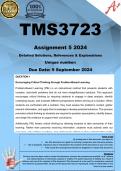TMS3723
Assignment 5 2024
Detailed Solutions, References & Explanations
Unique number:
Due Date: 9 September 2024
QUESTION 1
Encouraging Critical Thinking through Problem-Based Learning
Problem-Based Learning (PBL) is an instructional method that presents students with
complex, real-world problems that do not have straightforward solutions. This approach
encourages critical thinking by requiring students to engage in deep analysis, identify
underlying issues, and evaluate different perspectives before arriving at a solution. When
students are confronted with a problem, they must assess the problem's context, gather
relevant information, and apply their knowledge to develop potential solutions. This process
promotes critical thinking as students are required to question assumptions, identify biases,
and weigh the evidence to support their conclusions.
Additionally, PBL fosters critical thinking by allowing students to take ownership of their
learning. Rather than passively receiving information, students must actively seek out
resources, ask probing questions, and continuously reflect on their understanding of the
problem. This self-directed approach encourages students to think independently
Terms ofand
use
By making use of this document you agree to:
develop a more nuanced understanding of the subject matter. The iterative nature of
• Use this document as a guide for learning, comparison and reference purpose,
problem-solving
• Not toin PBL, where
duplicate, students
reproduce and/or revisit and refine
misrepresent their ideas
the contents based onasnew
of this document yourinsights,
own work,
• Fully accept the consequences should you plagiarise or misuse this document.
further deepens their critical thinking skills.
Disclaimer
Extreme care has been used to create this document, however the contents are provided “as is” without
any representations or warranties, express or implied. The author assumes no liability as a result of
reliance and use of the contents of this document. This document is to be used for comparison, research
and reference purposes ONLY. No part of this document may be reproduced, resold or transmitted in any
form or by any means.




